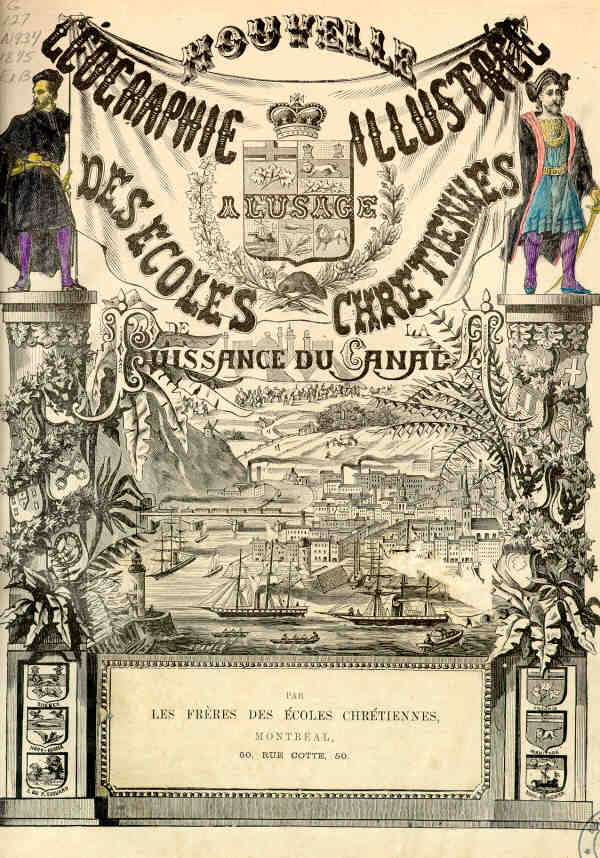
Canada
Frères des écoles chrétiennes. Nouvelle géographie illustrée à l’usage des écoles chrétiennes de la puissance du Canada. Montréal, 50, rue Cotté, 50, c1875. iv-94 p.Coming to Montreal from France in November 1837, the Brothers of the Christian Schools published their first textbook during the spring of 1838: Nouveau traité d’arithmétique: contenant toutes les opérations ordinaires du calcul, les fractions et les différentes réductions de fractions, les règles de trois, d’intérêt, de société, d’alliage, l’extraction des racines, les principes pour mesurer les surfaces et la solidité des corps: enrichi de 400 problèmes à résoudre, pour servir d’exercice aux élèves: à l’usage des écoles chrétiennes des frères. This opened the way to a double collaboration:a modification the French system of measurement was replaced by the English system of an original text published in France at least in 1831, renewed in 1914, and an agreement with a local printer to realize the project because the Brothers had, at that time, no experience in publishing.
From the spring of 1838 to the end of 1868, the Quebec Brothers wrote, but above all, borrowed from their French fellow members at least 18 titles, all published by various lay publishers. In 1869, a step was made toward autonomy by the re editing of A new treatise of the duties of a christian, first published the year before by Sadlier. The copyright is registred under the name of Brother Hosea (Éphrem Gagnon), a member of the community and, at that time, the Superior Provincial. First Canadian appointed to that function, he had been in charge for just a little over a year. For the first time, a book written by the Brothers was published, but there appeared no name of an editor or a printer. Instead of that, one finds at the bottom of the title page the adress of the residence of the Superior Provincial on Côté Street, Montreal. Since the Brothers had no press yet, they called upon external collaboration which they felt they did not have to identify. They took all the risks and accepted all the responsibilities. The following year, they did the same thing again which eventually identified them as publishers, this time with a book written in Quebec (Introduction au traité d’arithmétique commerciale, 1870).
The civil address appearing on a great many books gave a second indication to set the date from which the community publicly became a publisher. The Brothers had been living in Montreal since at least 1841, on a quadrilateral limited by the following streets: Côté, Vitré, Chenneville and Lagauchetière belonging to the Sulpicians. They eventually built a big house sheltering at the same time a boarding school, a novitiate, a house of retirement for older Brothers, the residence for the Provincial and a "Procure". Since the property was limited on the west side by rue Côté, it was given even civil numbers. The community has used indifferently 44 or 50 until 1927, and 984 when the city of Montreal decided to change the numbering. Is it out of timidity or of prudence that the community only indicates, at the bottom of the title page, the civil address of the head office, that is: 50, Cotté Street for A Compendium of sacred history (1869) or 44, Côté Street for A New Treatise of the duties of a Christian (also in 1869). It was only in 1871 that they used in full the name of the editor: "Frères des Écoles chrétiennes" at the bottom of the title page of Solutions des exercices et problèmes des traités d’arithmétique.
Early in the 1870 decade, the community controled two steps in the production of its textbooks: composition and edition; printing, only for a little while longer, was out of its control. In 1877, the Brothers bought, from the Montreal Episcopal Corporation, for 11 000.00$, a piece of land with a building on it at the south east corner of Côté and Vitré Streets, slantwise with their head office. The same year, or at the latest the following year, printer Joseph Chapleau, whom the Brothers had dealt with in the past while he was billeted at 10, St Charles Borromée (see, among others, Nouvelle géographie illustrée , 1875), moved into the building the Brothers had recently bought, and became, by far, their main printer. According to Lovell’s Montreal Directory, he was there until 1888 or 1889. Billeted so close to the Brothers’ "Procure", they, little by little, learned the trade of printing. The 1888 89 edition of the Lovell’s tells us that the occupant of 31 Côté Street is no longer "Chapleau, J. & Fils, printers" but "Christian Brothers, printers". The loop was looped: early in the 1890s,the Brothers acted as authors, editors, publishers and distributors of textbooks.
During the next 70 years, they were one of the main players in the world of teaching edition in Quebec, whether at the "Procure" in Montreal or at the "Centre pédagogique in Quebec". Meanwhile, the Toronto anglophone Brothers published only one or two books. Early in the 1960s, considering the development of lay publishers in the field of pedagogy, the Brothers chose a new trade name: Lidec (Librairie des écoles) evidently inspired by the success of their French fellow members who were publishing under the trade name of Ligel (Librairie générale de l’enseignement libre). Finally, in 1985, the community withdrew completely from that economic sector by selling all its assets to Guérin, a school editor.
Meanwhile, the Quebec Brothers abundantly used the publications of their overseas French fellow members: French (grammar and reading) and arithmetic especially. Such borrowing, although quite considerable in the 19th century, was cut down drastically at the beginning of the 20th century because of government requests asking for local products. Yet, the second world war brought again an upward movement.
See Paul Aubin, Les communautés religieuses et l’édition du manuel scolaire au Québec 1765 1964 , Sherbrooke, Groupe de recherche sur l’édition littéraire au Québec, 2001, 131 p.
http://revista_roma.delasalle.edu.mx/numero_6/paul_aubin_fr_6.pdf
